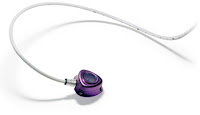Three years and four months after I received an implanted
access port - a PowerPort® made by Bard Access Systems (Salt Lake City, UT) - it was removed at MGH today. The access port, also called a port-a-cath, consists of a two basic units: a "portal" (a small reservoir with a silcone rubber membrane for needle access) and an attached "
catheter" , a plastic tube , which inserts into a large vein such as the
subclavian veins or jugular. The portal is implanted under the skin near the
clavicle (collar bone).
 |
Bard Access Port
showing portal and catheter |
The port is accessed using a needle which punctures the skin and the rubber membrane of the port. The membrane naturally seals around the needle and seals when the needle is removed. The device is designed to be accessed thousands of times. In the implantation procedure, the catheter is introduced into the vein using a placement tool which punctures the vein and allows the catheter to be inserted several centimeters into the vein as needed. The placement tool is extracted leaving the catheter in place.

